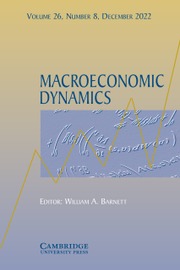Article contents
COORDINATION, CREDIT, AND AN ELASTIC CURRENCY
Published online by Cambridge University Press: 02 March 2005
Abstract
The market economy is modeled as a decentralized joint productionsystem. Markets in such an economy require the use of money or creditinstruments to facilitate exchange. As a result, market economies areat risk for monetary instability induced by real-side productioncoordination failure. In particular, economies decentralized viacentralized wholesaling markets are subject to precipitous collapses.The most stable monetary system is trade in specie. However, therevery likely is a scarcity of specie, which generates inefficiency anddiscourages production. There is, then, a need for an elasticcurrency. Bank-issued bills of exchange are a perfectly elasticmedium and eliminate the scarcity of specie and its attendantinefficiency, but are a less stable monetary system than is trade inspecie. In the trade-off between elasticity and stability, fiduciarycurrency (or fiduciary deposits) lies between specie and bank-issuedbills of exchange.
Information
- Type
- Research Article
- Information
- Copyright
- © 1997 Cambridge University Press
- 3
- Cited by

